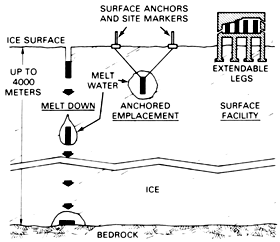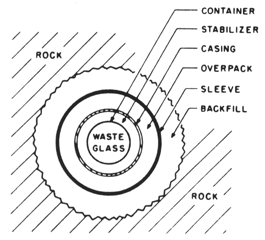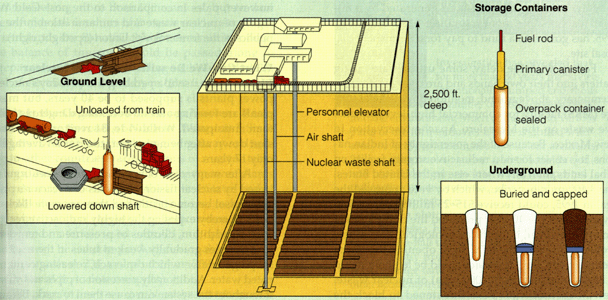 .
.
Waste Repository:A mythical place where nuclear waste can be safely stored.
When Spent Fuel is removed from a nuclear reactor, it has to go somewhere.
But where?
FORTUNATELY, smart people have worked on the problem for years and years. And years, and years, and years.
UNFORTUNATELY, they haven't come up with any workable solutions.
----------------------------------------------------------
Here are some drawings of things they've thought about, and thought about, and thought about, namely (in order, top left to bottom right): Ice storage, undersea storage, outer space storage, storage in a melted-rock cavity, and storage in a solid rock cavity.
 .
.

 .
.
--The above five images are from: Understanding Radioactive Waste, Third Edition, by Raymond L. Murray, Batelle Press, pages 125-127, Columbus, OH, 1989 (colorization by this author).
----------------------------------------------------------
The fanciful drawing below is a schematic diagram of a vitrified waste package. Titanium has been suggested as one of the alloys (read: Expensive!):

-- The above image is from: The Nuclear Energy Option: An Alternative for the 90s, by Bernard L. Cohen, page 184, Plenum Press, NY, 1990, 1992.
----------------------------------------------------------
The drawing below is offered as a "systems approach" because it uses multiple barriers in what is called "defense in depth". According to the accompanying text, these barriers might include cement, asphalt, and plastic (in a noncorrosive condition, it adds!):

-- Above image is from: Understanding Radioactive Waste, Third Edition, by Raymond L. Murray, page 99, Battelle Press, OH , 1989. (Colorized by this author.)
----------------------------------------------------------
It's so simple!
Or is it?
According to the DOE, here's all you have to do: Just drop the waste half a mile into the earth! The drawing shown below, in full color, was found in a school textbook, as a "proposed general design for deep-underground permanent storage of high-level radioactive wastes from commercial nuclear power plants in the United States."

-- The above image is from: Living in the Environment: Principles, Connections, and Solutions, Tenth Edition, by G. Tyler Miller, page 448, Wadsworth Publishing Co. CA, 1998.
The DOE no doubt estimates there will be more deaths from people falling down the personnel elevator than from accidents with the nuclear material they love so much!
----------------------------------------------------------
Copyright (c) 2002 by Russell D. Hoffman. All Rights Reserved